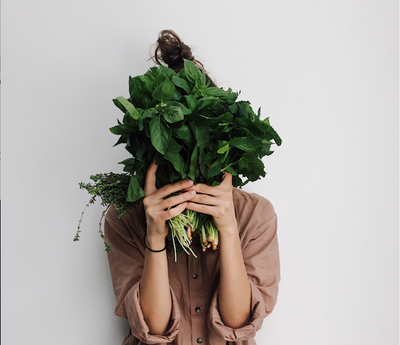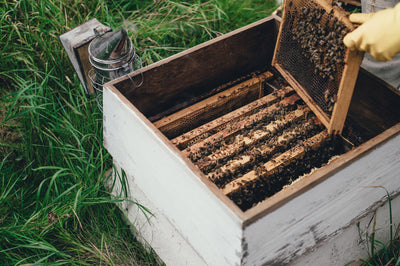How to rewild your garden

"To plant a garden is to believe in tomorrow." — Audrey Hepburn
Rambling green expanses. Carefully tended home turf. City squares peppered with pots. Whether small or stately, rural or urban, together, the UK’s gardens take up more space than all of our national nature reserves combined – meaning they’re not only vital for our wellbeing but the survival of our wildlife, too.
From growing your own mini meadow to building a hedgehog highway, there are plenty of things you can do to boost biodiversity, improve soil health and bring your garden back to life.
Here’s how to embrace nature and rediscover your wild side.
First, find out what sort of soil you’re working with
Some plants can only access the soil’s nutrients if the PH falls within a certain range, so it’s important to measure how acidic or alkaline your soil is before splashing out at the garden centre.
To test, dig a sample of soil, and either get yourself a soil testing kit, or you could try using vinegar and baking soda to reveal the general soil composition. A PH less than 7 is acidic, 7 is neutral and anything above 7 is alkaline.
Hydrangeas are nature’s litmus test, with the flowers turning pink in alkaline to neutral soil and blue in acidic soil.
"Hydrangeas are nature’s litmus test, with the flowers turning pink in alkaline to neutral soil and blue in acidic soil."
When looking for plants that will suit your space, it’s also important to consider how much sun your garden gets. Is it north or south-facing? Some plants love beaming rays, while others prefer dappled shade.
Give your mower a rest
The human world is carpeted in the most mundane of horticultural features: manicured, neatly-mowed lawns.
Not just dull to look at, lawns are biodiversity deserts, thanks to the lack of life they sustain. And, if you fertilise, mow and water them, they can also be a real drain on resources and scourge on the environment.
But, writes gardening columnist Alys Fowler, “there is another way”.
“Your lawn is already a wildflower meadow – every inch of soil is waiting for its moment to burst forth,” says Alys. “Those weeds are some of the best insect food, growing despite the weather, endlessly repeat blooming, rich in nectar and pollen. A seed bank is already there – it might even contain orchids. Oh, and perhaps plenty of moss, essential stuff for nests and nature of all sorts.”
“Your lawn is already a wildflower meadow – every inch of soil is waiting for its moment to burst forth. Those weeds are some of the best insect food, growing despite the weather, endlessly repeat blooming, rich in nectar and pollen."
Voles, shrews, toads, frogs and hedgehogs all like to move through long grass rather than out in the open. Caterpillars, who transform into butterflies and moths, feed on nettles, ivy and brambles. Meadows, brimming with wildflowers (of which we have lost 97% since the 1930s), are a foundation of biodiversity.
Campaigns like Plantlife’s No Mow May rally legions of gardeners to lock up their lawn mowers and let the wildflowers, moss and long grass grow.
If you don’t want to abandon your mower altogether, writes Alys, then “learn how to move the mower’s blades up, so the cut is higher than 10cm,” leaving a month between each mow over summer.
Or, why not grow a tapestry lawn? With no need for fertilisers, the tapestry lawn involves planting squares of varying hardy, perennial, flowering plants, which knit together to form a flower-filled blanket.
Grow your own dinner
 “One of the most radical and revolutionary things you can do,” writes Bryant McGill, “is grown your own food and eat from the land.”
“One of the most radical and revolutionary things you can do,” writes Bryant McGill, “is grown your own food and eat from the land.”
It’s also one of the most environmentally friendly things you can do, too, eliminating food air miles, providing wildlife habitat and enriching the soil.
Growing your own reconnects you with the land; reminding you where food comes from and sparking the kind of satisfaction that can only come from working with your hands and witnessing the process.
"Growing your own reconnects you with the land; reminding you where food comes from and sparking the kind of satisfaction that can only come from working with your hands and witnessing the process."
The Soil Association advises against leaving any soil bare when growing fruit and vegetables, as rain can wash away essential soil nutrients. Instead, keep it covered with edible crops, plants and cover crops.
Leafy greens like chard, spinach and Cavolo Nero are gratifyingly easy to grow, versatile and tasty. Microgreens and sprouts make excellent quick nutrition and can be grown in jars on windowsills if outdoor space is limited. Legumes, like green beans, peas and lentils, are nourishing for both body and earth, thanks to their mutually beneficial relationship with bacteria in the soil.
Build a hedgehog highway

The UK’s only spiny mammal, the hedgehog, is in sharp decline, with numbers dropping by almost a third in the last 20 years.
Hedgehogs are nocturnal nomads, walking a mile or more each night looking for food and a mate – often through our gardens. But with their fences and walls, those gardens are usually too restrictive for hedgehogs to roam freely.
By creating safe corridors by making holes in fences and walls (13cm by 13cm should be sufficient), you can help to expand the UK’s ‘Hedgehog Highway’ – and allow hedgehogs to pass easily through your garden.
Enrich and improve your soil, naturally 
While you might not pay much attention to the mud beneath your boots, soil is essential to life on Earth – and its deteriorating state spells trouble for us all.
“Scoop up a shovelful of healthy soil,” writes environmental scientist Nathan Donley, “and you’ll likely be holding more living organisms than there are people on Earth.
“Like citizens of an underground city that never sleeps, tens of thousands of subterranean species of invertebrates, nematodes, bacteria and fungi are constantly filtering our water, recycling nutrients and helping to regulate the planet’s temperature.”
“Scoop up a shovelful of healthy soil, and you’ll likely be holding more living organisms than there are people on Earth."
But in fields and farms across the globe, a toxic soup of pesticides is wreaking havoc, according to a study published earlier this year. And the issue isn’t just an industrial one, either. Alarming levels of toxic chemicals known as PFAS were recently found in home fertiliser, leading to contaminated home produce.
Thankfully, whether you have acres of land, an allotment or just a window box, there’s always something you can do to help conserve soil health. Why not try:
- Making your own garden compost using kitchen scraps and plant waste. This will ‘feed’ your soil with a diverse array of nutrients and microorganisms.
- Creating a wormery. Compact and faster than standard composting, a wormery uses the digestive ability of worms to turn rotting vegetable matter into nutrient-rich, natural compost (and a nutritious liquid fertiliser) for your plants. Follow this step-by-step guide from Gardener’s World to make your own.
- Leaving organic matter like dead leaves and wilted plants to return to the soil rather than clearing them away.
Get pally with companion plants
 By shielding each other from the elements, offering natural protection from pests and enriching the soil with nutrients, companion plants create a kind of friendly garden community.
By shielding each other from the elements, offering natural protection from pests and enriching the soil with nutrients, companion plants create a kind of friendly garden community.
Perhaps the best-known companion plants are the ‘three sisters’ – squashes, beans and corn. The corn creates a structure for the beans to climb, while the beans add nitrogen to the soil to feed the squashes.
Companion planting is also a brilliant way to attract beneficial insects like lacewings, hoverflies and ladybirds (AKA the best natural predators of aphids and whitefly).
Rocket Gardens’ companion plant starter pack contains Marigolds, Tagetes and Nasturtiums, and is the ideal way to give companion planting a go. Not only will these plants look beautiful dotted in between your veggies, they all have the advantage of being edible too. Try using their petals and leaves to garnish salads and prettify deserts.
Create a pond
 Digging a pond might be one of the most important things you can do to boost biodiversity in your garden.
Digging a pond might be one of the most important things you can do to boost biodiversity in your garden.
"Digging a pond might be one of the most important things you can do to boost biodiversity in your garden."
Ponds provide vital habitat for wetland wildlife such as frogs, toads, newts, dragonflies and water boatmen, and offer a haven for swallows and swifts, who pick off insects from above the water’s surface and use muddy areas for nest building.
Whether you’re short on space or have acres to fill, ponds can be as small or large as you like – all will be beneficial. The Wildlife Trusts website explains how to make one.
Plant an insect’s paradise
Insects have declined in abundance by 75% or more in the past 50 years. Bumblebee populations are steadily shrinking, while the number of common butterflies, such as meadow browns and peacocks, fell by 46% between 1976 and 2017.
While we might think of insects as ‘bugs’, they are essential to the normal functioning of our world. We need them to pollinate our food crops and flowers, keep the soil healthy and feed animals like birds, fish and frogs.
But there’s plenty you can do in your humble patch of green to boost insect numbers. Firstly, plant a good range of native species, which indigenous insects are more likely to eat. Add shrubs, tussock grasses, trees and flowering ground-cover species to provide habitat. Pollinators like bees, butterflies and moths need flowers, making English cottage favourites like foxgloves and hollyhocks an ideal choice.
Consider the principles of Biodynamic Gardening

Rooted in the work of philosopher and scientist Dr Rudolf Steiner, Biodynamics is a holistic, ecological and ethical approach to farming, gardening, food and nutrition.
From the idea that a garden is an integrated living organism to the use of compost enlivened with biodynamic preparations, biodynamic principles and practices can be applied anywhere food is grown, with “thoughtful adaptation to scale, landscape, climate and culture.”
Head over to the Biodynamic Gardening page and discover a bounty of articles, webinars and video series to help you learn and grow.
8 THINGS TO DO IN THE GARDEN THIS MONTH:
-
If you’re going away, plan to have your garden plants cared for.
-
Make sure that the birds have a water source in dry spells.
-
Deadhead flowers as they fade.
-
Harvest runner beans, cucumbers, tomatoes and courgettes.
-
Sow brassicas in time for planting out in autumn, and endives and chicories ready for winter salads.
-
Keep young plants well-watered, and feed and water plants in containers regularly (as often as every other day in hot weather).
-
If the weather turns wet, keep an eye out for signs of blight on your tomato and potato plants. Remove infected leaves, or, if the plant is riddled, cut it down at soil level.
-
Finally, if you fancy a healthy, clean (and legal!) way to relax in your garden after all your hard work, then why not try smoking some herbs? Peruse this list of commonly-grown herbs that create a smooth, tasty smoke and give a gentle, relaxing buzz.



















































